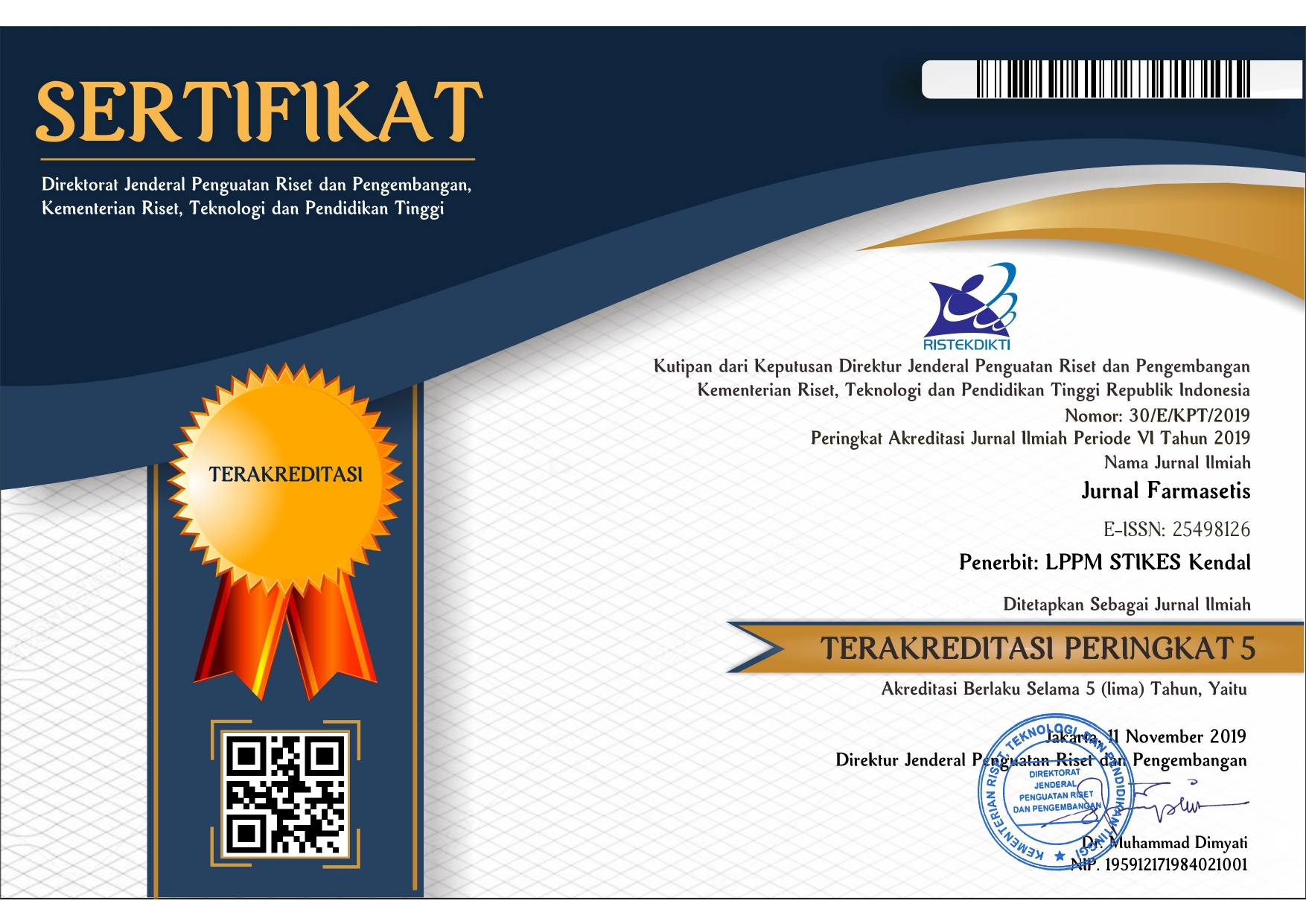Hubungan Kadar Kadmium dalam Darah terhadap Hemoglobin pada Petugas Las
DOI:
https://doi.org/10.32583/far.v12i4.1869Keywords:
cd, hemoglobin, hb, kadmium, pekerja lasAbstract
Pekerja bengkel las berpotensi terpapar uap logam berat yang dihasilkan selama proses pengelasan. Salah satu uap logam berat yang dihasilkan dari industri pengelasan adalah kadmium (Cd). Cd masuk ke dalam jaringan dan menyebabkan stres oksidatif, sehingga salah satu akibatnya adalah penghambatan sintesis heme. Penelitian ini bertujuan untuk mengetahui hubungan antara kadar Cd dalam darah terhadap hemoglobin pada pekerja las. Metode: Penelitian ini merupakan penelitian cross-sectional dengan teknik purposive sampling. Analisis kadar Cd dalam darah menggunakan Spektrofotometer Serapan Atom (SSA), dan analisis kadar Hb menggunakan Fotometer Clima MC-15. Kadar Cd dan Hb yang diperoleh kemudian diuji korelasi menggunakan uji Rank Spearman Hasil: Hasil uji korelasi didapatkan nilai signifikansi 0,842, dimana nilai sig. 0,842>0,05. Hal ini menunjukkan bahwa tidak ada hubungan antara kadar Cd dengan kadar Hb. Diskusi: Penelitian ini dapat disimpulkan, bahwa tidak ada hubungan kadar Cd dan kadar Hb dalam darah pekerja las. Penelitian ini perlu dilanjutkan dengan memperluas cakupan wilayah dan memperketat kriteria responden seperti tidak merokok.
References
Agency for Toxic Substance and Disease Registry. (2012). ToxGuideTM for Cadmium Cd. Atlanta: Division of Toxicology and Human Health Sciences.
Andjelkovic, M., Buha Djordjevic, A., Antonijevic, E., Antonijevic, B., Stanic, M., Kotur-Stevuljevic, J., ... & Bulat, Z. (2019). Toxic effect of acute cadmium and lead exposure in rat blood, liver, and kidney. International journal of environmental research and public health, 16(2), 274.
Argonne National Laboratories. (2001). Cadmium, Human Health Fact Sheet, Argonne National Laboratories, Lemont, Ill, USA.
Baloch, S., Kazi, T. G., Baig, J. A., Afridi, H. I., & Arain, M. B. (2020). Occupational exposure of lead and cadmium on adolescent and adult workers of battery recycling and welding workshops: Adverse impact on health. Science of the Total Environment, 720, 137549.
Bernhoft R. A. (2012). Mercury toxicity and treatment: a review of the literature. Journal of environmental and public health, 2012, 460508. https://doi.org/10.1155/2012/460508
Bernhoft, R. A. (2013). Cadmium toxicity and treatment. The Scientific World Journal.
Cetintepe, S.P., Iritas, S.B., Gunduzoz, M. et al. Relation Between Lung Dysfunction and Blood Cadmium and Lead Levels Among Welders. (2019). Expo Health 11, 13–19. https://doi.org/10.1007/s12403-017-0262-x
G. F. Nordberg,K.Nogawa,M. Nordberg, and L. Friberg. (2007). “Cadmium,” in Chapter 23 in Handbook of toxicology of Metals Eds., pp. 445–486, Elsevier, Amsterdam, The Netherlands, 3rd edition.
Gandasoebrata, R. (2013). Penuntun Laboratorium Klinik. Jakarta: Dian Rakyat
Ganguly, K., Levänen, B., Palmberg, L., Åkesson, A., & Lindén, A. (2018). Cadmium in tobacco smokers: a neglected link to lung disease?. European Respiratory Review, 27(147).
Hounkpatin, A. S. Y., Edorh, P. A., Guédénon, P., Alimba, C. G., Ogunkanmi, A., Dougnon, T. V., ... & Creppy, E. E. (2013). Haematological evaluation of Wistar rats exposed to chronic doses of cadmium, mercury and combined cadmium and mercury. African Journal of Biotechnology, 12(23).
Matović, V., Buha, A., Ðukić-Ćosić, D., & Bulat, Z. (2015). Insight into the oxidative stress induced by lead and/or cadmium in blood, liver and kidneys. Food and Chemical Toxicology, 78, 130-140.
Pahlawan, S.D., & Keman, S. (2014). Korelasi Kadar Plumbum Darah Dengan Kadar Hemoglobin dan Hematokrit. Jurnal Kesehatan Lingkungan, Vol. 7, No. 2, 159-165.
Rumahlatu, D. (2012). Konsentrasi Logam Brat Kadmium pada Air, Sedimen dan Deadema setosum (Echinodermata, Echinoidea) di Perairan Pulau Ambin. ILMU KELAUTAN: Indonesian Journal of Marine Scences, 16 (2), 78-85. https://doi.org/10.147/ik.ijms.16.2.78-85.
Sasongko, A., Yulianto, K., & Sarastri, D. (2017). Verifikasi metode penentuan logam kadmium (Cd) dalam air limbah domestik dengan metode spektrofotometri serapan atom. JST (Jurnal Sains dan Teknologi), 6(2), 228-237.
Sugiharto, S. B., Suwarso, S., & Prawirohardjono, W. (2016). Level kadmium darah dan fungsi ginjal ditinjau dari kadar ureum dan kreatinin pekerja las bengkel knalpot di Purbalingga. Berita Kedokteran Masyarakat, 32(4), 119-124.
Suh, Y. J., Lee, J. E., Lee, D. H., Yi, H. G., Lee, M. H., Kim, C. S., ... & Kim, S. K. (2016). Prevalence and relationships of iron deficiency anemia with blood cadmium and vitamin D levels in Korean women. Journal of Korean Medical Science, 31(1), 25-32.
Świergosz‐Kowalewska, R. (2001). Cadmium distribution and toxicity in tissues of small rodents. Microscopy research and technique, 55(3), 208-222.
Timchalk, C., Lin, Y., Weitz, K. K., Wu, H., Gies, R. A., Moore, D. A., & Yantasee, W. (2006). Disposition of lead (Pb) in saliva and blood of Sprague-Dawley rats following a single or repeated oral exposure to Pb-acetate. Toxicology, 222(1-2), 86-94
Tsany, F. F. Z. A. (2019). Analisis Faktor Risiko Paparan Kadmium pada Pekerja Bengkel Las di Yogyakarta (Doctoral dissertation, Univesrsitas Islam Indonesia).
Zahra, N., & Kalim, I. (2017). Perilous effects of heavy metals contamination on human health. Pakistan Journal of Analytical & Environmental Chemistry, 18(1), 1-17.
Downloads
Published
How to Cite
Issue
Section
License
Copyright (c) 2023 Mastuti Widi Lestari, Tasrif Ahmad, Sulasmi Sulasmi

This work is licensed under a Creative Commons Attribution-NonCommercial-NoDerivatives 4.0 International License.







